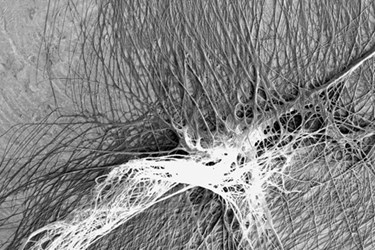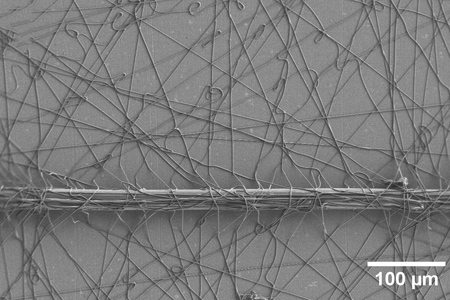Spider Webs Provide Template For Ultra-Strong Biomedical Adhesives
By Joel Lindsey

A team of researchers at the University of Akron may have developed a more efficient class of biomedical adhesives by mimicking patterns used by spiders when constructing webs.
“This adhesive architecture holds promise for potential applications in the area of adhesion science, particularly in the field of biomedicine where the cost of the materials is a significant constraint,” the researchers wrote in an article published recently in the Journal of Polymer Science.
The researchers involved with the project mimicked a technique used by spiders when spinning webs. More specifically, the researchers created synthetic replicas of “attachment discs,” which are clusters of threads spread out over the top of an underlying silk thread that essentially “staple” the bottom thread to another object.
According to a press release published recently on Akron’s website, these clusters use a minimal amount of material yet create remarkably strong points of adhesion.
In order to replicate attachment discs, researchers used a process called electrospinning, in which an electrical charge draws out very fine fibers from a liquid material — in this case polyurethane — to create a network of ultra-thin threads. These threads were then spread out over the top of an underlying nylon thread, effectively pinning it in place the same way a spider pins in place one of its threads.

Electrospun Polyurethane Synthetic Attachment Discs
“Instead of using big blobs of glue, for example, we can use this unique and efficient design of threads pinning down a fiber,” Ali Dhinojwala, professor of polymer science at UA and lead researcher on the project, said in the press release. “The inspiration was right in front us, in nature.”
Dhinojwala and other researchers claim that the adhesion achieved through this process could be strong enough to attach tendons to bones or to bind bone fractures. Such a technique, they say, could provide cheaper, more efficient, and ultimately more accessible modes of medical treatment.
“Experimental and theoretical evidence are provided to confirm the advantages of thousands of micron-size ‘staple-pins’ and their low peeling angles to enhance the adhesive forces required to peel the natural and synthetic attachment discs,” researchers wrote in their Journal of Polymer Science article. “These results provide a unique architectural design for fabricating new adhesives that uses very little material for various biomedical and material science applications.”
Image Credit: The University of Akron
